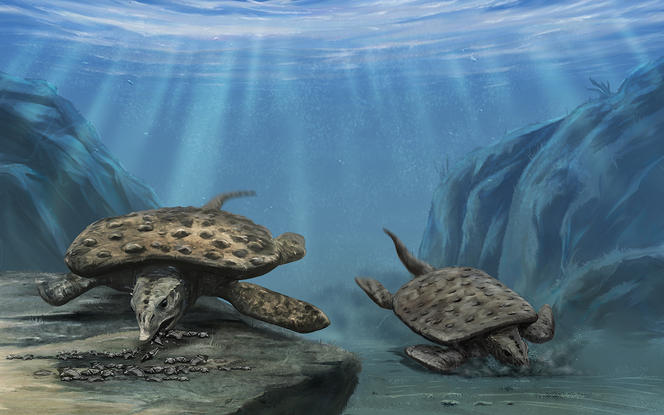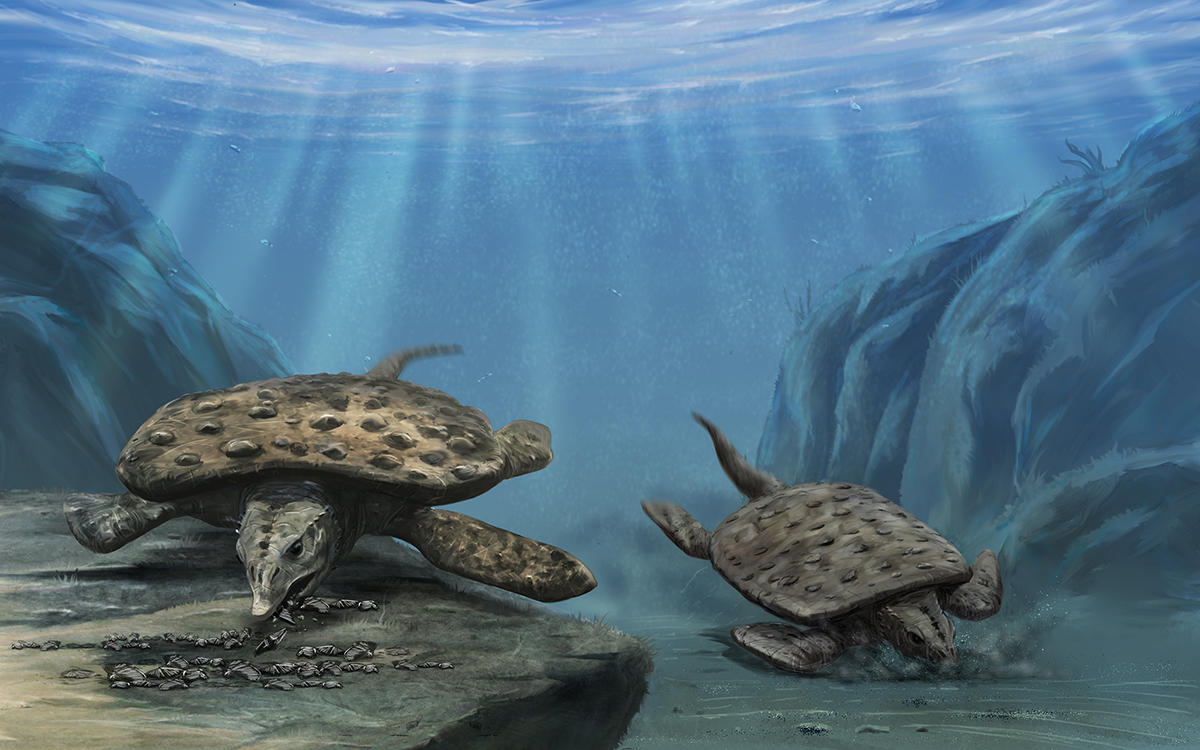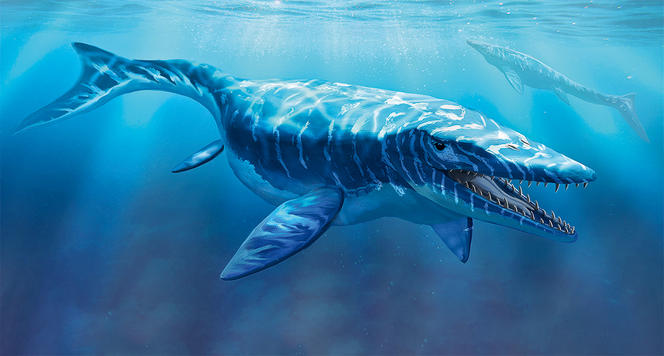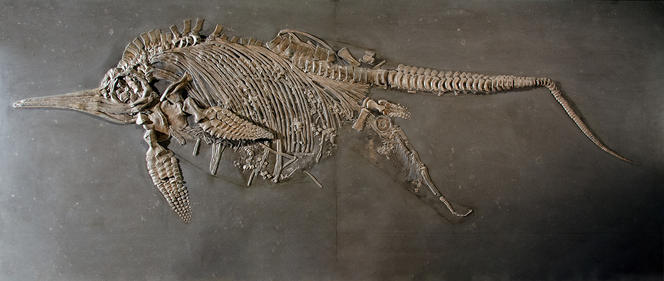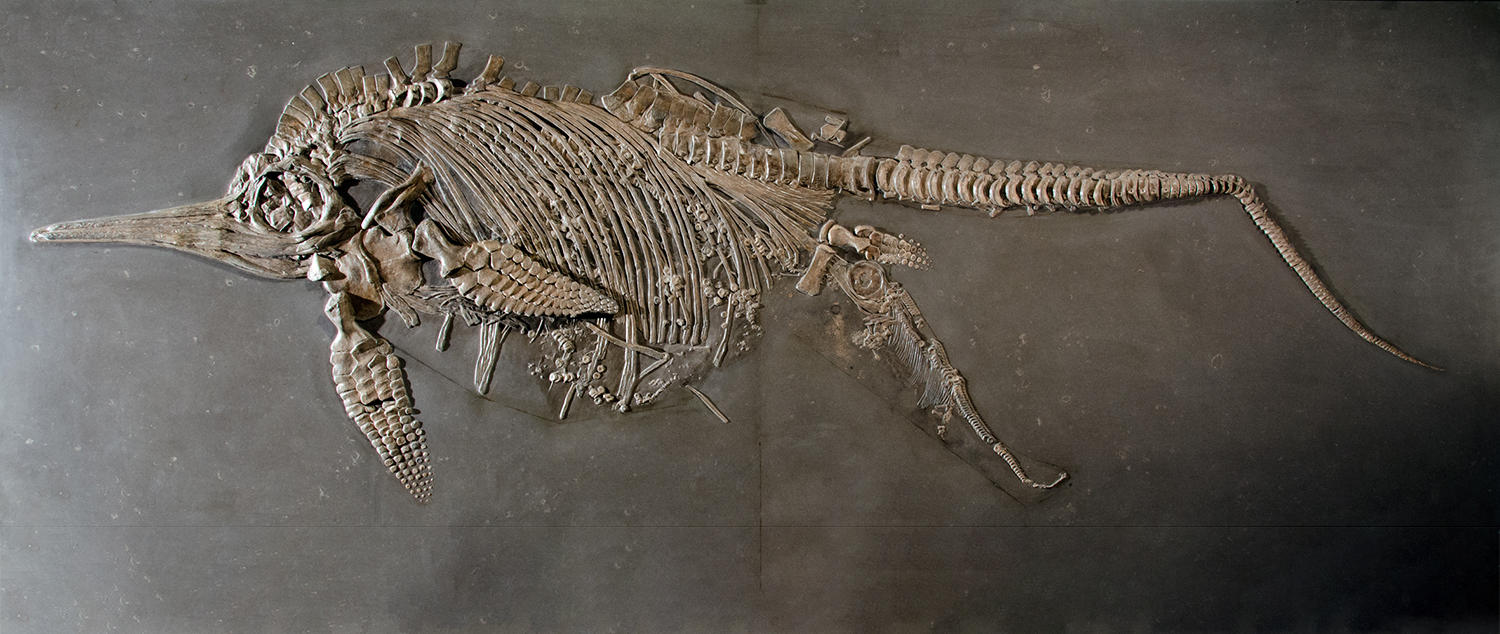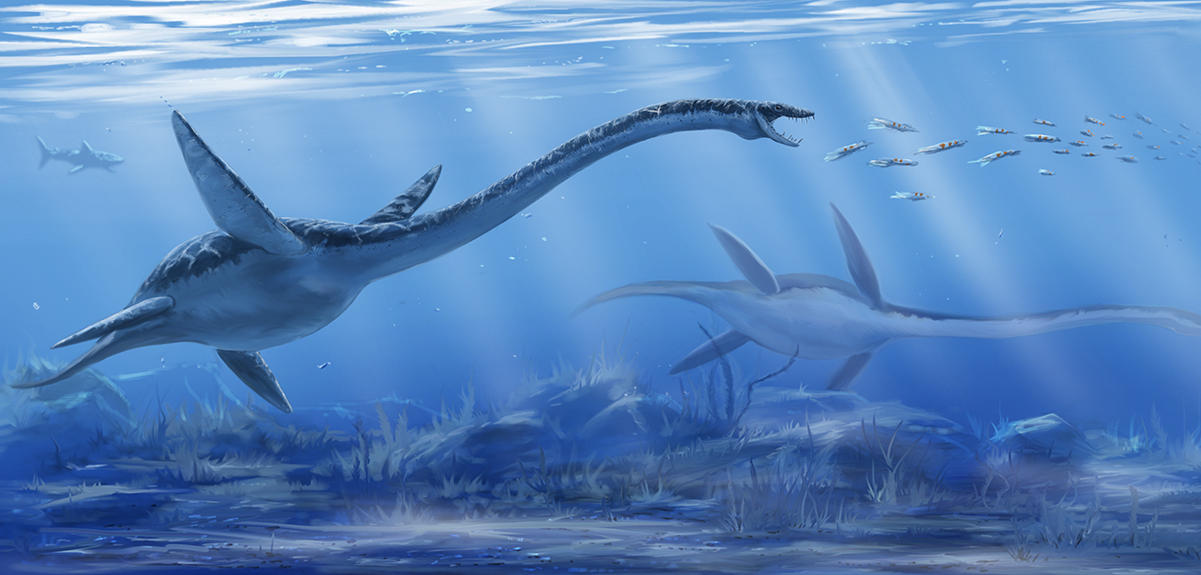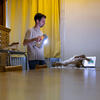You are here
Sea monsters at the time of the dinosaurs
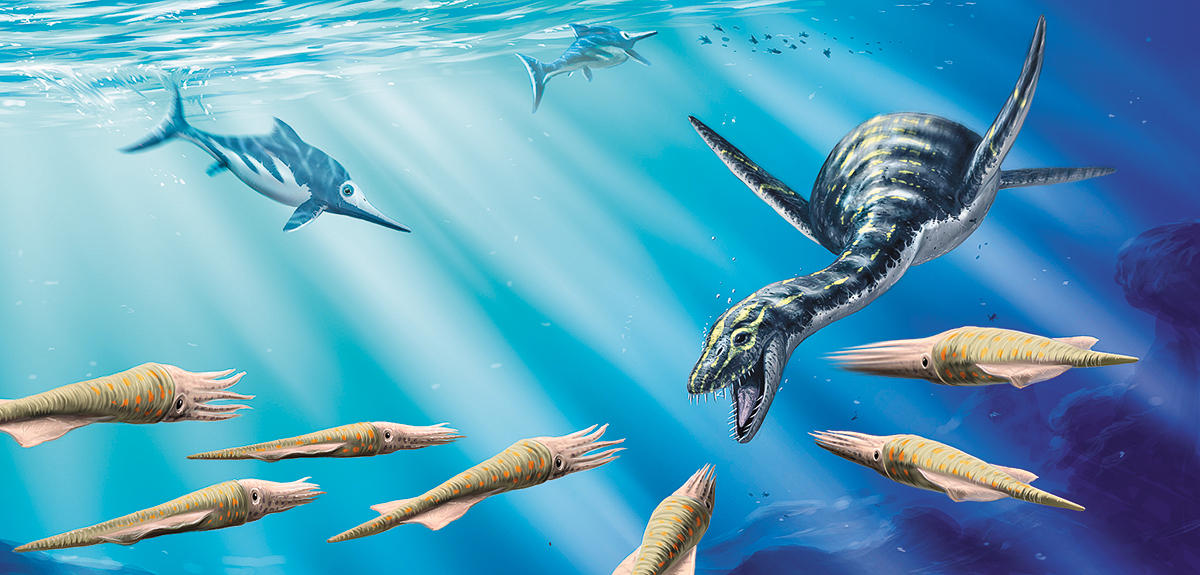
How many species of marine reptile lived during the Mesozoic Era, when dinosaurs ruled the Earth? And how many remain today?
Nathalie Bardet:1 During the Mesozoic Era (252 to 66 million years ago), there were at least five hundred species, belonging to ten or so orders of reptiles. In fact, new ones are discovered every year. The only so-called ‘marine’ reptiles left today are one crocodile, one lizard, a few turtles and some snakes.
The word comes from the Latin reptilis, meaning ‘creeping’ or ‘crawling’. The ancestors of marine reptiles were land-dwellers, weren't they?
N. B.: Yes, all of them. Then, in the Mesozoic, they returned to the sea, just as mammals like the cetaceans and sirenians did much later on, in the Tertiary Period. This took place following the Permian-Triassic extinction event 252 million years ago, during which 95% of animal species disappeared. As a result, the reptiles ‘abandoned ship’ and returned to the ocean!
Alexandra Houssaye:2 As in all such events, the Permian-Triassic crisis left ecological niches vacant. Hardly any predators or competitors remained, making it easier for the reptiles to diversify and proliferate. The extinction was followed by a phase of radiation which saw the rapid emergence of new species.
Do we know who their land-dwelling ancestors were?
Peggy Vincent:3 Not always. For example, when that iconic group, the ichthyosaurs, first appeared in the fossil record, they had already gone through many changes, making it difficult to identify their terrestrial ancestor.
A. H.: The evolution of certain groups, on the other hand, is clearly evident. For example, the first mosasaurs looked like monitor lizards. They still had legs instead of flippers, and their compact bones prove that they were slow swimmers that stayed at shallow depths. They subsequently became active swimmers; they used their extended tails to propel themselves forward, their legs turned into swimming paddles, and their skeletons became lighter. These changes happened very quickly, in just a few million years.
Did marine reptiles occupy every level in the food chain?
N. B.: Of the approximately five hundred known species, only one ate aquatic plants. All the others were carnivores, with some feeding on shellfish, crustaceans or fish – and, for the largest ones, on other marine reptiles. Basically, there were small, large, and huge predators, which were therefore at the top of the food chain.
What were the main adaptations that enabled reptiles to master the oceans?
P. V.: The most important one was to be able to move around in an aquatic environment, and be agile enough to feed and come up to the surface to breathe. All of them adapted in their own way, even if they had some points in common. The majority had limbs that had been transformed into swimming paddles. The most streamlined were the ichthyosaurs, large cruisers that were found in every ocean. Nearly all had a dorsal fin and a two-lobed tail like those of today's sharks or tuna.
What other changes did they undergo?
N. B.: There was a whole range of physiological, morphological and behavioural adaptations. In addition to what Peggy has just mentioned, there is an example that I particularly like: the nostrils. They were no longer at the end of the snout as in a normal reptile, but had moved up towards the forehead. A similar evolutionary trend can be observed in today's cetaceans: the blowholes of dolphins and whales are actually their nostrils.
P. V.: Their thermophysiology has changed as well. Marine reptiles are now confined to seas with mild temperatures. However, some Mesozoic specimens lived near the poles. Analysis of stable oxygen isotopes in their bones shows that they may have had a high body temperature, as much as 35 or 36 °C in the case of plesiosaurs and ichthyosaurs.
A. H.: These results are consistent with those obtained from the analysis of the nature of their bone tissue. This is also a good physiological indicator since it varies according to whether the animals were cold-blooded or warm-blooded. Slow-growing bones are found in species with a low metabolic rate, and fast-growing bones in animals able to produce body heat. In this respect, the bones of ichthyosaurs and plesiosaurs have features similar to those of birds and mammals, showing that they had a fast metabolism.
That's amazing. We always think of reptiles as being cold-blooded animals.
N. B.: That's true. But consider an ichthyosaur crossing vast expanses of ocean. It couldn't lie around every morning warming up in the sun like a lizard before becoming active!
And what adaptations were there concerning reproduction?
N. B.: Many terrestrial reptiles are oviparous, in other words, they lay eggs. In the vastness of the ocean though, that's a bit tricky. Large marine reptiles couldn't return to the beach because they would have risked being stranded, like whales. And laying just a few hard-shelled eggs in water wasn't viable either. So they developed a type of viviparity in which, instead of eggs, the young emerged fully formed from their mother's womb. This viviparity was acquired very quickly. Thanks to some exceptional fossils, we now know that in the earliest ichthyosaurs of the Triassic, the young emerged head first. But in an aquatic environment, they could easily drown. In later ichthyosaurs, the tail came out first, as in modern cetaceans. I find this change in their reproductive mechanism quite extraordinary!
Did they raise their young?
N. B.: It's hard to say. These animals were so different from today's reptiles that you can't rely on comparisons. Hypotheses about behaviour are difficult to demonstrate when you're working with fossils.
P. V.: The problem most of the time is that we have very few fossils. Regarding plesiosaurs, we’ve only got one skeleton of a mother with an embryo in the womb, so it's difficult to generalise. But we can speculate that, if she had just one offspring, she would have cared for it more. This idea is based on hypothetical models of reproductive strategies: according to the r-selection strategy, a species privileges high numbers of offspring, whereas with the K-selection strategy, it produces fewer offspring that require extensive parental care.
A. H.: In fact, a recent study of the bone structure of a plesiosaur embryo suggests that they gave birth to a single large offspring.
66 million years ago, a meteorite impact ushered in the Cretaceous-Tertiary crisis that led to the extinction of the dinosaurs. What effect did it have on marine reptiles?
P. V.: The end of the Cretaceous was indeed marked by major upheavals. Prior to the meteorite strike, intense volcanic activity had also begun in India, and both these phenomena had a major impact on the planet. Not all reptiles reacted in the same way. Some disappeared, like the plesiosaurs and mosasaurs, while others, such as turtles and crocodiles, survived the crisis. What you need to look at is the state of the populations before the event, to see if the groups became extinct gradually or were suddenly wiped out. What we see from the fossil record is that, just before then, mosasaur and plesiosaur populations were spread right across the globe and were highly diverse. So we believe that it was a sudden extinction.
Do we know why some survived and others didn't?
N.B.: Extinction events are selective. The general trend is for smaller animals that are not directly linked to primary production, such as detritivores, to be more resilient. However, there are examples to the contrary, such as sea turtles, in which no reduction in biodiversity is observed. In the current state of our knowledge it is still difficult to say why some organisms survive mass extinctions and others don’t.
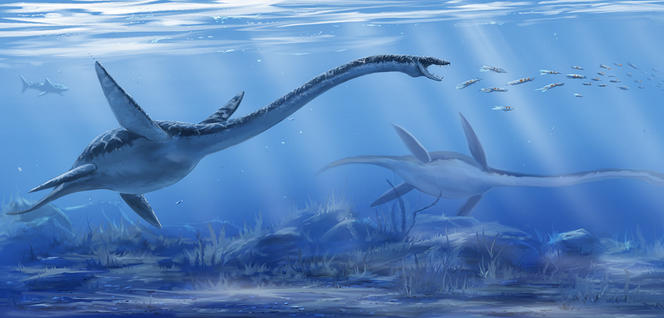
One final question: among this wide range of extinct species, is there one that you are especially fond of?
P. V.: I particularly like Elasmosaurus. It was a species of plesiosaur that had an incredibly long neck with a tremendous number of vertebrae, as many as seventy, at the end of which there was a very small head.
N. B.: For me it would be Mosasaurus. It was like a giant marine lizard. The smallest species in the same family were three metres long, while the largest, like this one, measured fifteen metres. It was first described by Georges Cuvier, the founding father of palaeontology.
A. H.: If I had to choose, it would be the placodonts, which had a shell, or carapace, although they were not related in any way to turtles. All the evidence suggests that they were slow, lumbering animals that crawled along the seabed and fed on shellfish. And yet, when we examine their bones, we can see rapid growth, suggesting a high metabolic rate. There's something wrong there, something puzzling. If I could bring just one marine reptile back to life, I'd choose a placodont, because I don't understand them.
Further reading: La mer au temps des dinosaures (The Oceans at the Time of the Dinosaurs), N. Bardet, A. Houssaye, S. Jouve and P. Vincent, Belin, Hors collection Sciences, September 2021, 208 pages.
- 1. CNRS senior researcher at the Centre for Research on Palaeontology - Paris (CR2P – CNRS / MNHN / Sorbonne Université).
- 2. CNRS senior researcher at the Adaptive Mechanisms and Evolution laboratory (MECADEV – CNRS / MNHN).
- 3. CNRS senior researcher at the Centre for Research on Palaeontology - Paris (CR2P – CNRS / MNHN / Sorbonne Université).


